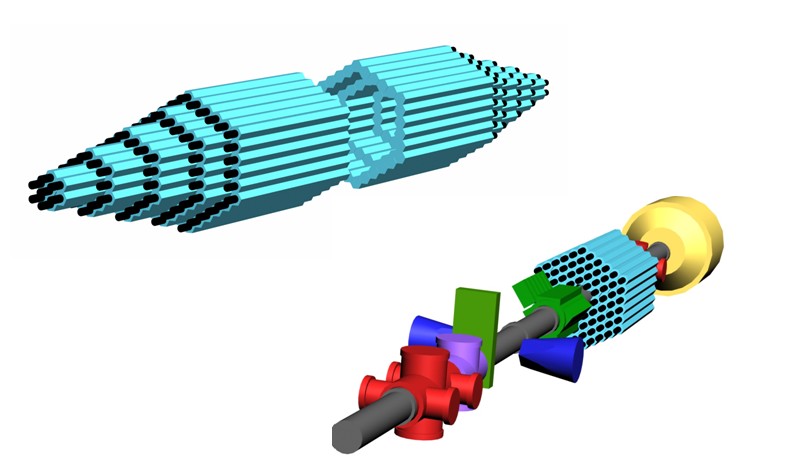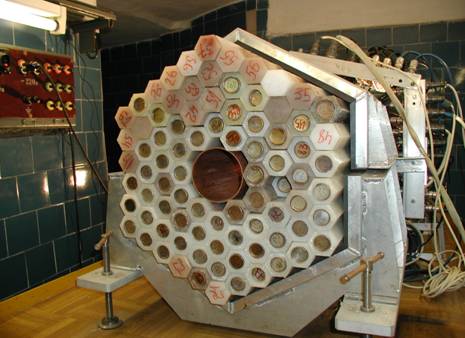Partenaires
The TETRA setup
Physics motivation
It is expected the with the advent of new machine to produce neutron-rich species like SPIRAL2, our knowledge about nuclear properties in the region close to the neutron drip-line in the region of Z=28-50 will extent considerably.
When moving further and further away from the valley of stability, the Q values for beta decay increase more and more. Close to the drip line, beta-delayed particle emission is observed. On the neutron-rich side, beta-delayed two-neutron emission has been evidenced for 7 nuclei with branching ratios ranging from 1% to 10% (and estimated to up to 50% for 34Na). However, correlations between the two neutrons have not been searched for in these nuclei.
These correlations can give valuable information about the pairing of nucleons inside the atomic nucleus. This information is not accessible otherwise. Neutrons are not disturbed by the Coulomb barrier and correlations should be observable outside the nucleus. So, two-neutron emission has a decisive advantage over two-proton emission.
In addition to their interest for correlation studies, the decay characteristics of these nuclei are also of interest for the modeling of the astrophysical rapid-neutron capture process.
For identifying new two-neutron emitters and for studying their decays, these isotopes have to be implanted into a catcher, which is surrounded by a high-efficiency, high-granularity beta-, gamma- and neutron detection systems. The half-life of the nucleus, the energy of the betas and gammas and in particular the angle between the two neutrons will be measured.
There are three areas where beta-delayed two-neutron emission is possible. For the lightest nuclei, the beta-delayed two-neutron emission was experimentally well established. Search for beta-delayed two-neutron emission in the Br-Rb and the Sb-Sn regions of the chart of nuclei is an interesting experimental task.
The majority of the new Pn values were deduced from the ratios of simultaneously measured beta and delayed-neutron activities. It was only in a few cases that spectroscopic data were used to determine the one or other decay property (e.g. independent Pn determinations for 93Br, 100Rb and 135Sn).
Nuclear structure properties of neutron-rich nuclei are of paramount importance for the understanding and modeling of the r-process, which is responsible for the synthesis of approximately half of the elements heavier than Iron. Presently available experimental information about basic properties such as masses and decay schemes of neutron-rich nuclei does not include nuclei in the r-process path in the regions between the N=50, 82 and 126 shells. Systematic studies of basic nuclear structure properties of neutron-rich isotopes for (possibly) all elements from Fe to Sn, covering all “waiting-point” nuclei in the r-process path, is very important.
Most of our understanding of nuclear structure relies on the existence of shell gaps appearing for specific nucleon numbers called magic numbers. The study of the evolution of these gaps far from stability has been a motivation for many experiments. The magic number Z=50 is already known for its continuity far from stability. Actually, the Sn isotopes keep their magic character from N=50 to N=82. Probing the persistence of the shell gap at N=50 from Z=50 down to Z=28 represents an extremely active field of investigation in nuclear structure nowadays. Furthermore, 80Zn is a critical nucleus in the calculation of the r process of stellar nucleosynthesis, and the most general calculation of this process requires detailed knowledge of the properties of this nucleus.
Detection setup
The neutron detectors consist of several tens of separate modules comprising a 3He-filled proportional counter, a moderator, a high-voltage input and a preamplifier.
The detectors operate as follows: the neutrons emitted by a source are moderated to become thermalized. Then, diffusing within the detector, they either are absorbed by the counters and by the moderator or leave the detector. Helium counters detect neutrons by using the thermal neutron-induced reaction 3He + n -> 3H + p + 780 keV, with a cross section of 5320 barns. Thus, a neutron can be detected just once, and in principle the so-called cross-talk effect is excluded. Since thermal neutrons are involved, the energy threshold is almost zero. Helium counters are practically insensitive to gamma rays.
The detectors are used for measuring the multiplicities and the angular characteristics of neutrons originating in the decay of light neutron-rich nuclei. The neutron detection efficiency was is expected to be 0.30-0.60, and the angular resolution is about 10-20o depending on the type and number of counters. 90 counters (gas pressure 7 atm, length 50 cm, diameter 3.2 cm) are repsently available. To get better angle resolution with high and constant efficiency in a wide neutron energy range, it is necessary to change the counters to shorter ones (20-25 cm in length) and increase the total numbers of counters up to 250- 300.
The following figures show two possible arrangements of the TETRA device.

Key experiments
One region of interest is beta-delayed two-neutron emission from fission products in 132Sn mass region. It is proposed to measure the beta-delayed two-neutron emission probability along the chains of very neutron-rich isotopes in the Z≈50, N>82 region.
The effect to be detected is a possible odd-even effects in the P2n values.
Another topic might be the study of the isotopes in the Cu to Nb and the Sn to Xe region. The beta-delayed neutron emission is a threshold effect. Thus, we are interested to find the decays to the collective states located just above the S2n threshold in the daughter nuclei.
The amount of the beta strength entering into the Q![]() -2n window may differ for neighbouring isotopes. The degree of the P2n values staggering carries an important information on the interplay of nuclear deformation and paring.
-2n window may differ for neighbouring isotopes. The degree of the P2n values staggering carries an important information on the interplay of nuclear deformation and paring.
Depending on the S2n values, the P2n values should be a sensitive probe of the so-called “shell-quenching” effect widely discussed recently.

Contact: Yuri Penionzhkevich


 To read, in the same section...
To read, in the same section...
- Trap-assisted conversion-electron spectroscopy , 17 June 2010.
- Beta Decay Total Absorption Spectrometer , 28 June 2008.
- Beta-delayed charged particle emission , 16 April 2008.
- Super-allowed 0+ -> 0+ beta decays , 5 April 2008.